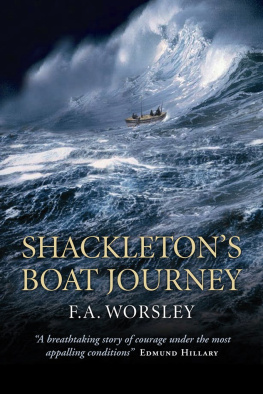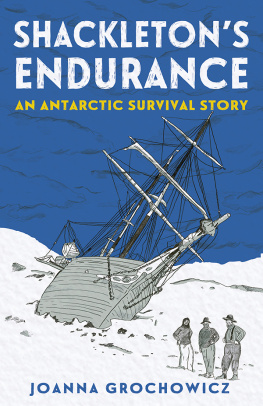SOUTH
THE STORY OF SHACKLETON'S LAST EXPEDITION, 1914-1917
* * *
ERNEST HENRY SHACKLETON
*
South
The Story of Shackleton's Last Expedition, 1914-1917
From a 1919 edition
ISBN 978-1-62011-365-3
Duke Classics
2012 Duke Classics and its licensors. All rights reserved.
While every effort has been used to ensure the accuracy and reliability of the information contained in this edition, Duke Classics does not assume liability or responsibility for any errors or omissions in this book. Duke Classics does not accept responsibility for loss suffered as a result of reliance upon the accuracy or currency of information contained in this book.
Contents
*
Dedication
*
TO
MY COMRADES
WHO FELL IN THE WHITE WARFARE OF THE SOUTH AND ON THE RED FIELDS OF FRANCE AND FLANDERS
Preface
*
After the conquest of the South Pole by Amundsen, who, by a narrowmargin of days only, was in advance of the British Expedition underScott, there remained but one great main object of Antarcticjourneyingsthe crossing of the South Polar continent from sea to sea.
When I returned from the 'Nimrod' Expedition on which we had to turnback from our attempt to plant the British flag on the South Pole,being beaten by stress of circumstances within ninety-seven miles ofour goal, my mind turned to the crossing of the continent, for I wasmorally certain that either Amundsen or Scott would reach the Pole onour own route or a parallel one. After hearing of the Norwegiansuccess I began to make preparations to start a last great journeysothat the first crossing of the last continent should be achieved by aBritish Expedition.
We failed in this object, but the story of our attempt is the subjectfor the following pages, and I think that though failure in the actualaccomplishment must be recorded, there are chapters in this book ofhigh adventure, strenuous days, lonely nights, unique experiences, and,above all, records of unflinching determination, supreme loyalty, andgenerous self-sacrifice on the part of my men which, even in these daysthat have witnessed the sacrifices of nations and regardlessness ofself on the part of individuals, still will be of interest to readerswho now turn gladly from the red horror of war and the strain of thelast five years to read, perhaps with more understanding minds, thetale of the White Warfare of the South. The struggles, thedisappointments, and the endurance of this small party of Britishers,hidden away for nearly two years in the fastnesses of the Polar ice,striving to carry out the ordained task and ignorant of the crisesthrough which the world was passing, make a story which is unique inthe history of Antarctic exploration.
Owing to the loss of the 'Endurance' and the disaster to the 'Aurora',certain documents relating mainly to the organization and preparationof the Expedition have been lost; but, anyhow, I had no intention ofpresenting a detailed account of the scheme of preparation, storing,and other necessary but, to the general reader, unimportant affairs, assince the beginning of this century, every book on Antarcticexploration has dealt fully with this matter. I therefore brieflyplace before you the inception and organization of the Expedition, andinsert here the copy of the programme which I prepared in order toarouse the interest of the general public in the Expedition.
"The Trans-continental Party.
"The first crossing of the Antarctic continent, from sea to sea viathe Pole, apart from its historic value, will be a journey of greatscientific importance.
"The distance will be roughly 1800 miles, and the first half of this,from the Weddell Sea to the Pole, will be over unknown ground. Everystep will be an advance in geographical science. It will be learnedwhether the great Victoria chain of mountains, which has been tracedfrom the Ross Sea to the Pole, extends across the continent and thuslinks up (except for the ocean break) with the Andes of South America,and whether the great plateau around the Pole dips gradually towardsthe Weddell Sea.
"Continuous magnetic observations will be taken on the journey. Theroute will lead towards the Magnetic Pole, and the determination of thedip of the magnetic needle will be of importance in practicalmagnetism. The meteorological conditions will be carefully noted, andthis should help to solve many of our weather problems.
"The glaciologist and geologist will study ice formations and thenature of the mountains, and this report will prove of great scientificinterest.
"Scientific Work by Other Parties.
"While the Trans-continental party is carrying out, for the BritishFlag, the greatest Polar journey ever attempted, the other parties willbe engaged in important scientific work.
"Two sledging parties will operate from the base on the Weddell Sea.One will travel westwards towards Graham Land, making observations,collecting geological specimens, and proving whether there aremountains in that region linked up with those found on the other sideof the Pole.
"Another party will travel eastward toward Enderby Land, carrying outa similar programme, and a third, remaining at the base, will study thefauna of the land and sea, and the meteorological conditions.
"From the Ross Sea base, on the other side of the Pole, another partywill push southward and will probably await the arrival of the Trans-continental party at the top of the Beardmore Glacier, near MountBuckley, where the first seams of coal were discovered in theAntarctic. This region is of great importance to the geologist, whowill be enabled to read much of the history of the Antarctic in therocks.
"Both the ships of the Expedition will be equipped for dredging,sounding, and every variety of hydrographical work. The Weddell Seaship will endeavour to trace the unknown coast-line of Graham Land, andfrom both the vessels, with their scientific staffs, important resultsmay be expected.
"The several shore parties and the two ships will thus carry outgeographical and scientific work on a scale and over an area neverbefore attempted by any one Polar expedition.
"This will be the first use of the Weddell Sea as a base forexploration, and all the parties will open up vast stretches of unknownland. It is appropriate that this work should be carried out under theBritish Flag, since the whole of the area southward to the Pole isBritish territory. In July 1908, Letters Patent were issued under theGreat Seal declaring that the Governor of the Falkland Islands shouldbe the Governor of Graham Land (which forms the western side of theWeddell Sea), and another section of the same proclamation defines thearea of British territory as 'situated in the South Atlantic Ocean tothe south of the 50th parallel of south latitude, and lying between 20degrees and 80 degrees west longitude.' Reference to a map will showthat this includes the area in which the present Expedition will work.
"How the Continent will be crossed.
"The Weddell Sea ship, with all the members of the Expeditionoperating from that base, will leave Buenos Ayres in October 1914, andendeavour to land in November in latitude 78 degrees south.
"Should this be done, the Trans-continental party will set out ontheir 1800-mile journey at once, in the hope of accomplishing the marchacross the Pole and reaching the Ross Sea base in five months. Shouldthe landing be made too late in the season, the party will go intowinter quarters, lay out depots during the autumn and the followingspring, and as early as possible in 1915 set out on the journey.









